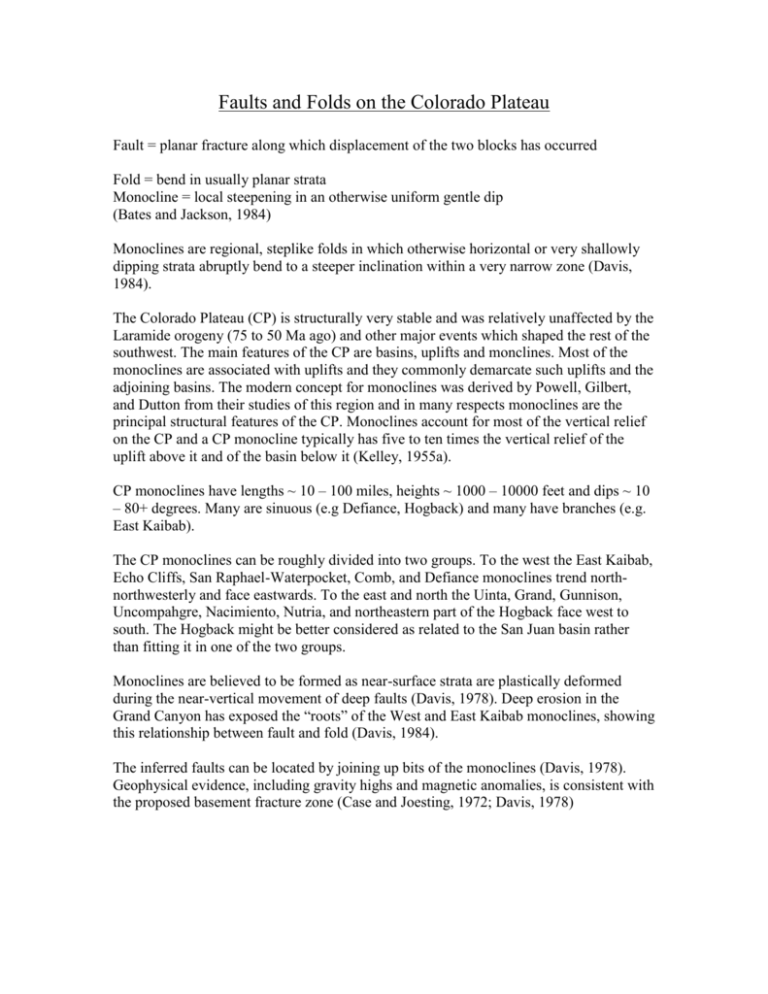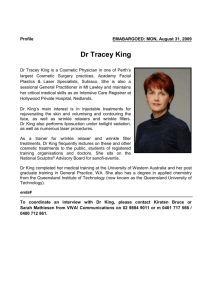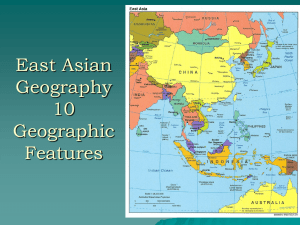Faults and Folds on the Colorado Plateau
advertisement

Faults and Folds on the Colorado Plateau Fault = planar fracture along which displacement of the two blocks has occurred Fold = bend in usually planar strata Monocline = local steepening in an otherwise uniform gentle dip (Bates and Jackson, 1984) Monoclines are regional, steplike folds in which otherwise horizontal or very shallowly dipping strata abruptly bend to a steeper inclination within a very narrow zone (Davis, 1984). The Colorado Plateau (CP) is structurally very stable and was relatively unaffected by the Laramide orogeny (75 to 50 Ma ago) and other major events which shaped the rest of the southwest. The main features of the CP are basins, uplifts and monclines. Most of the monoclines are associated with uplifts and they commonly demarcate such uplifts and the adjoining basins. The modern concept for monoclines was derived by Powell, Gilbert, and Dutton from their studies of this region and in many respects monoclines are the principal structural features of the CP. Monoclines account for most of the vertical relief on the CP and a CP monocline typically has five to ten times the vertical relief of the uplift above it and of the basin below it (Kelley, 1955a). CP monoclines have lengths ~ 10 – 100 miles, heights ~ 1000 – 10000 feet and dips ~ 10 – 80+ degrees. Many are sinuous (e.g Defiance, Hogback) and many have branches (e.g. East Kaibab). The CP monoclines can be roughly divided into two groups. To the west the East Kaibab, Echo Cliffs, San Raphael-Waterpocket, Comb, and Defiance monoclines trend northnorthwesterly and face eastwards. To the east and north the Uinta, Grand, Gunnison, Uncompahgre, Nacimiento, Nutria, and northeastern part of the Hogback face west to south. The Hogback might be better considered as related to the San Juan basin rather than fitting it in one of the two groups. Monoclines are believed to be formed as near-surface strata are plastically deformed during the near-vertical movement of deep faults (Davis, 1978). Deep erosion in the Grand Canyon has exposed the “roots” of the West and East Kaibab monoclines, showing this relationship between fault and fold (Davis, 1984). The inferred faults can be located by joining up bits of the monoclines (Davis, 1978). Geophysical evidence, including gravity highs and magnetic anomalies, is consistent with the proposed basement fracture zone (Case and Joesting, 1972; Davis, 1978) Wherever a fault responsible for a monocline can be seen in the Grand Canyon exposures it is found to be a reactivated Precambrian fault. It is reasonable to suggest that this is true in the CP as a whole. The compressive forces which reactivated the faults and caused the monoclines were due to the Laramide uplift which occurred as the North American continental crust collided with oceanic plate to the west 75 to 50 Ma ago. 1 - The monoclines are upper-crustal expressions of near-vertical components of movements on reactivated, Precambrian, high-angle fault zones. 2 - The systematic distribution and orientation pattern of the monoclines reflects attributes of a rejuvenated basement-block mosaic partitioned by ancient, deep-seated faults. 3 – The reactivation of Precambrian fault and fracture zones to produce monoclines was caused by northeast-southwest regional compression during the Laramide orogeny. (Davis, 1978) Are similar features seen on other planets? Seeing compressive features is reasonably easy, identifying folds without field geology is less so. The most similar features are wrinkle ridges, seen on lunar mare and the plains of Mars and Mercury (Banerdt et al, 1992; Golombeck et al, 1991; Melosh and McKinnon, 1988; Watters, 1991). A wrinkle ridge is a linear asymmetric topographic high, typically having considerable morphological complexity. The basic physiography of a wrinkle ridge is a broad rise with a superposed hill and a low relief wrinkle on top of the hill. Early hypotheses for the origin of these features centred on volcanism but evidence of vertical offsets across ridges, ridges extending into highland regions as fault scarps and offsets in pre-existing craters transected by ridges favours a tectonic origin. Plescia and Golombeck (1986) concluded that wrinkle ridges are anticlines overlying thrust faults, and Watters (1988) suggested that the best terrestrial analogues are anticlinal ridges in the Miocene flood basalts of the western Columbia Plateau. Note that no lunar samples show the plastic deformation expected in folding (Heiken et al, 1991) Venus, outer planet satellites? There's got to be a morning after If we can hold on through the night We have a chance to find the sunshine Let's keep on lookin' for the light It's not too late, we should be giving Only with love can we climb It's not too late, not while we're living Let's put our hands out in time Oh, can't you see the morning after? It's waiting right outside the storm Why don't we cross the bridge together And find a place that's safe and warm? (South Park, after The Poseiden Adventure) There's got to be a morning after We're moving closer to the shore I know we'll be there by tomorrow And we'll escape the darkness We won't be searchin' any more References: Banerdt, W. B., Golombeck, M. P., and Tanaka, K. L., 1992, Stress and tectonics on Mars, in “Mars”, University of Arizona, eds Kieffer. H. H., Jakosky, B. M., Snyder, C. W., and Matthews, M. S. Bates, R. L., and Jackson, J. A., 1984, “Dictionary of Geological Terms – 3rd ed.”, Anchor Case, J. E., and Joesting, H. E., 1972, Regional geophysical investigations in the central Colorado Plateau, U. S. Geol. Survey Prof. Paper 763 Crack, S. S. H., 1999, The Spitale tribute, Hawthorne House Productions Davis, G. H., 1978, Monocline fold pattern of the Colorado Plateau, in “Laramide folding associated with basement block faulting in the western United States”, Geological Society of America Memoir 151, ed. Matthews, V., pp 215-235 Davis, G. H., 1984, Structural geology of rocks and regions, J. Wiley Golombeck, M. P., Plescia, J. B., and Franklin, B. J., 1991, Faulting and folding in the formation of planetary wrinkle ridges, Proc. Lunar Planet. Sci. Conf. 21st, pp 679-693 Kelley, V. C., 1955a, Monoclines of the Colorado Plateau, Geol. Soc. Am. Bull., v. 66, pp 789-804 Kelley, V. C., 1955b, Regional tectonics of the Colorado Plateau and relationship to the origin and distribution of uranium, New Mexico Univ. Pubs. Geology, no. 5 Kelley, V. C., and Clinton, N. J., 1960, Fracture systems and tectonic elements of the Colorado Plateau, New Mexico Univ. Pubs. Geology, no. 6 Heiken, G. H., Vaniman, D. T., and French, B. M., 1991, “Lunar Sourcebook”, CUP Plescia, J. B., and Golombeck, M. P., 1986, Origin of planetary wrinkle ridges based on the study of terrestrial analogues, Geol. Soc. Am. Bull., v. 97, pp 1289-1299 Melosh, H. J., and McKinnon, W. B., 1988, Tectonic history of Mercury, in “Mercury”, University of Arizona, eds Vilas, F., Chapman, C. R., and Mathews, M. S. Plateau uplift: mode and mechanism, 1979, Tectonophysics special issue, v. 61, pp 1-336 Watters, T. R., 1986, Wrinkle ridge assemblages on the terrestrial planets, J. Geophys. Res., v. 93, pp 10236-10254 Watters, T. R., 1991, Origin of periodically spaced wrinkle ridges on the Tharsis Plateau of Mars, J. Geophys. Res., v. 96, pp 15599-15616







